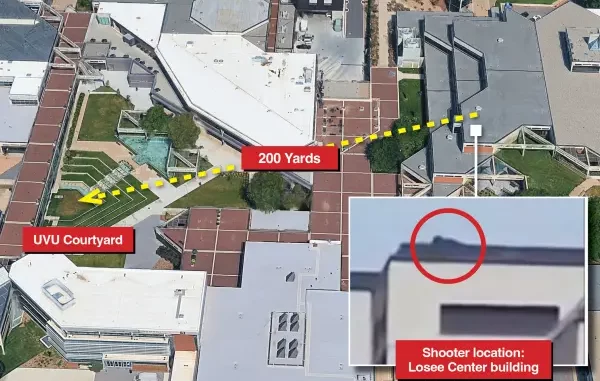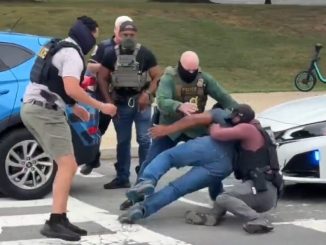
Published September 12, 2025
Background:
On September 10, 2025, federal and Utah state authorities reported an unidentified person of interest in relation to an assassination attempt on Charlie Kirk. Reports indicate that officials “have no idea” where the suspect is currently located. This report seeks to independently assess the circumstances, security protocols, and potential lapses that may have contributed to the incident.
Key Questions for Investigation:
-
Situational Awareness & Surveillance Gaps
-
Why were security personnel unable to detect the positioning of the unidentified person on the rooftop?
-
Were there blind spots in surveillance coverage that allowed the suspect to remain unnoticed?
-
What real-time monitoring systems were in place, and were they functioning optimally at the time?
-
-
Security Protocols
-
What are the standard security protocols for protecting high-profile individuals in public or semi-public locations?
-
Are there additional emergency protocols that are activated when a potential threat is identified?
-
How often are security drills conducted to simulate rooftop or elevated threats?
-
-
Preventive Measures
-
Could the assassination have been prevented with existing measures, or were there gaps in planning and execution?
-
What improvements, if any, are being considered to prevent similar threats in the future?
-
Were law enforcement and private security personnel fully coordinated during the event?
-
-
Environmental and Operational Factors
-
What environmental or structural factors (e.g., lighting, visibility, roof access points) contributed to the difficulty in spotting the suspect?
-
Was there interference with electronic surveillance (e.g., cameras, drones) or human observation due to crowd density or terrain?
-
Were prior intelligence reports available about potential threats, and were they acted upon?
-
-
Accountability and Reporting
-
Who is responsible for rooftop and perimeter security at the location?
-
Are there protocols for rapid reporting and escalation if a threat is detected?
-
How is inter-agency communication handled during a high-threat scenario?
-
Additional Factors for Consideration:
-
Previous threats or intelligence regarding individuals targeting high-profile figures in the area.
-
Historical analysis of rooftop or elevated attacks and the security measures used in those cases.
-
The role of technology (drones, AI-assisted monitoring) in supplementing human observation.
-
Coordination between local law enforcement, federal agencies, and private security teams.
-
Risk assessment policies for events, including evacuation routes and crowd management.

A drone shows the reported location of the shooter on a rooftop, at the scene where Charlie Kirk was fatally shot during an event at Utah Valley University.
 Point-Of -View
Point-Of -View
The recent assassination attempt on Charlie Kirk has raised urgent questions about the effectiveness of security measures protecting high-profile figures. Federal and Utah state authorities have admitted they “have no idea” where the unidentified suspect is located, prompting concerns over surveillance and threat detection.
Security experts point to several possible reasons the suspect went undetected, including limited visibility, natural blind spots, and insufficient monitoring of elevated areas like rooftops. Televised footage of the event even shows the individual clearly on a rooftop, suggesting that optical aids or long-range monitoring systems may not have been fully utilized. Environmental factors such as lighting, roof access points, and crowd density likely further complicated detection efforts.
This incident also highlights potential gaps in protocol and coordination. Were emergency escalation procedures followed? Were personnel trained for nontraditional threats, such as attacks from elevated positions? How effectively did multiple agencies communicate and respond in real time? These questions underline the need for proactive, rather than reactive, security planning.
The incident further raises serious questions about accountability. What responsibility do the security personnel bear, given that they appear to have been negligent in detecting the suspect’s positioning? Investigators and the public alike are calling for a thorough review of individual and organizational actions, including whether lapses in vigilance, coordination, or adherence to protocols contributed to the security failure. Establishing accountability is essential not only for justice but also for ensuring that similar vulnerabilities are addressed and prevented in the future.
Preventive measures must be reassessed to close surveillance gaps, improve situational awareness, and enhance coordination between law enforcement and private security. Only through a thorough review of current protocols and targeted improvements can similar threats be mitigated in the future, ensuring the safety of high-profile individuals and public confidence in protective measures.
 Bottom Line:
Bottom Line:
The failed detection of the rooftop suspect during the Charlie Kirk assassination attempt highlights glaring gaps in security and surveillance. This incident is a stark reminder that vigilance cannot be reactive—security measures, training, and inter-agency coordination must be anticipatory. Accountability must be enforced, preventive protocols strengthened, and operational blind spots addressed to ensure high-profile individuals are protected and public confidence in safety measures restored.






Be the first to comment